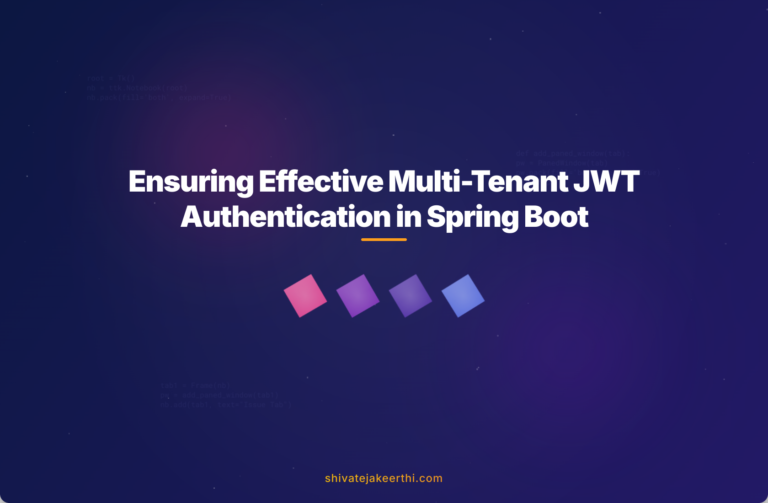Securing multi-tenant applications in Spring Boot is challenging, especially when each tenant requires its own isolated user database. If you’ve tried building a multi-tenant system using JWT authentication, you’ve likely experienced an issue—the wrong tenant database getting selected, or confusion arising when threads access the same default database.
When using JWT, authentication needs to be seamlessly integrated with your tenant infrastructure. A common pitfall is Spring Security handling JWT-based authentication concurrently within different threads. Threads might end up targeting a default tenant database instead of the tenant-specific databases you’re expecting.
Before we move forward, let’s clarify what we’re dealing with exactly. To achieve proper tenant isolation, each client’s data needs to live separately—but Spring Boot threads (often used with asynchronous methods) can sometimes pick up the default configured database instead of using the correct tenant identifier at runtime. This results in unexpected behavior, including authentication failures, incorrect user detail retrieval, or unauthorized database access.
Let’s start by looking closely at the issue.
Analyzing the Multi-Tenant JWT Authentication Issue
During debugging, you might have observed that multiple calls to authenticate users using JWT result in database connection mix-ups. With asynchronous methods or parallel processing, tenant identifiers aren’t consistently picked up, causing confusion.
Debugging logs typically show that authentication attempts happen without explicitly identified tenants—resulting in Spring falling back on the default datasource. Authentication attempts on different tenant databases thus become unreliable, failing intermittently, and causing confusion because of shared resources across tenants.
The exact symptom is that, when concurrent authentication processes run together, you might see warnings or stack traces denoting that multiple tenant contexts are being simultaneously considered.
To see a simplified view, consider these symptoms:
- Authentication unpredictably failing for different tenants during parallel requests.
- Logs showing incorrect datasource URLs randomly selected during JWT validation.
- User details retrieval wrongly hitting the default database sometimes.
This inconsistency directly arises from improper Tenant Context and DataSource configurations.
If you’d like to take a closer look at what you’re experiencing, you can find all relevant code and debug processes in my dedicated GitHub project repository for this scenario.
Requesting Assistance
Currently, there is an urgent need for help to properly configure a reliable default database setup during JWT authentication flows in a multi-tenant scenario. Achieving consistency in tenant identification is key to success, and your insights on this matter are warmly welcomed!
Let’s quickly revisit our implemented components to pinpoint errors clearly.
User Entity Details
We’ve structured our User entity around essential Spring Boot components and Hibernate standards:
@Entity
@Table(name="users")
public class User {
@Id
@GeneratedValue(strategy=GenerationType.IDENTITY)
private Long id;
private String username;
private String password;
private String email;
private String role; // ADMIN or USER
}
User Controller Implementation
Our UsersController connects user management HTTP endpoints directly to our user logic:
@RestController
@RequestMapping("/api")
public class UsersController {
@Autowired
private UsersService usersService;
@GetMapping("/user/{username}")
public User getUser(@PathVariable String username) {
return usersService.findUserByUsername(username);
}
}
User Service for Business Logic
The UsersService gathers queries against tenant-specific user databases:
@Service
public class UsersService {
@Autowired
private UserRepository userRepository;
public User findUserByUsername(String username){
return userRepository.findByUsername(username);
}
}
UserDetailService Implementation
In our custom service, MyUserService, which implements Spring Security’s UserDetailsService, we manage tenant-specific security details:
@Service
public class MyUserService implements UserDetailsService {
@Autowired
private UsersService usersService;
@Override
public UserDetails loadUserByUsername(String username) throws UsernameNotFoundException{
User user = usersService.findUserByUsername(username);
return new UserPrincipal(user);
}
}
JWT Token Service Implementation
Our JWT handling involves generating and validating tokens securely using the JWTService:
@Service
public class JWTService {
private String secret = "secretKey";
public String generateToken(UserDetails userDetails){
return Jwts.builder()
.setSubject(userDetails.getUsername())
.setIssuedAt(new Date())
.setExpiration(new Date(System.currentTimeMillis() + 86400000)) //1 day expiry
.signWith(SignatureAlgorithm.HS256, secret).compact();
}
public boolean validateToken(String token, UserDetails userDetails){
String username = getUsernameFromToken(token);
return (username.equals(userDetails.getUsername()) && !isTokenExpired(token));
}
// ... additional JWT methods
}
UserPrincipal for Authentication
This class integrates user information into Spring Security’s mechanism seamlessly:
public class UserPrincipal implements UserDetails {
private User user;
public UserPrincipal(User user){
this.user = user;
}
@Override
public Collection getAuthorities(){
return Collections.singleton(() -> user.getRole());
}
@Override
public String getUsername(){
return user.getUsername();
}
@Override
public String getPassword(){
return user.getPassword();
}
// ... other UserDetails method overrides
}
Security Configuration & JWT Filter
The JwtFilter integrates into the Spring Security filter chain for JWT processing, intercepting request headers appropriately to enforce authentication.
Tenant Context & Data Source Management
To avoid datasource confusion, our TenantContext leverages ThreadLocal storage, helping maintain tenant details within a thread scope. The MultiTenantConnectionProviderImpl and CurrentTenantIdentifierResolverImpl hold the keys:
- MultiTenantConnectionProviderImpl: Controls identification and provisioning of data source per tenant.
- CurrentTenantIdentifierResolverImpl: Helps in resolving the correct tenant identifier for runtime requests.
DataSource & Hibernate Configuration
Bean configurations outline connection and transaction management. Your properties file should look similar to this:
spring.jpa.hibernate.multiTenancy=SCHEMA
spring.jpa.hibernate.tenant_identifier_resolver=your.package.CurrentTenantIdentifierResolverImpl
spring.jpa.hibernate.multi_tenant_connection_provider=your.package.MultiTenantConnectionProviderImpl
Expected Outcome
Ultimately, we want isolated databases correctly selected every time a JWT token authentication action happens. Tenant identifiers should always get resolved properly to prevent database collisions. Implementing these configurations should result in seamless scaling and manageability of your multi-tenant Spring Boot environment.
Resolving multi-tenant JWT issues in Spring Boot is undoubtedly challenging. However, by closely inspecting your thread management, JWT setup, tenant resolver, and database connection configurations, you’ll reach an optimal solution quickly.
Have you faced similar challenges in your multi-tenant JWT configuration? How did you address them? Share your experiences in the comments below, or suggest improvements for this approach!



0 Comments